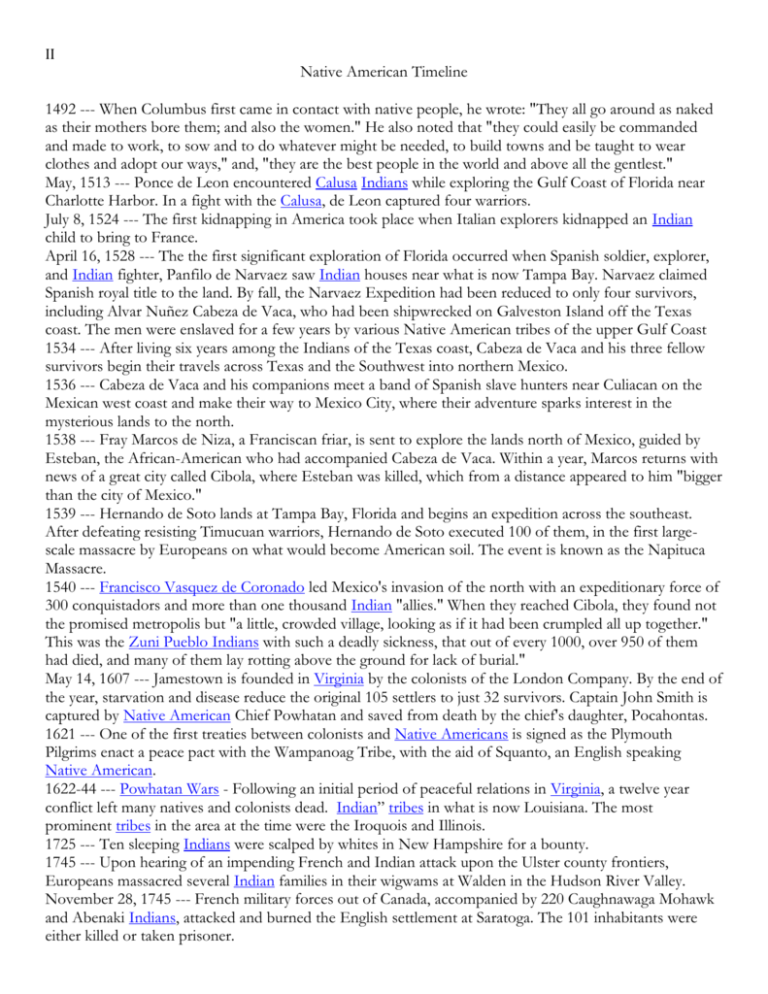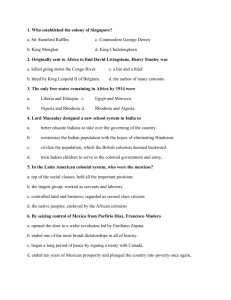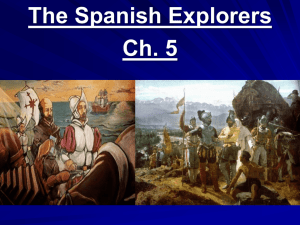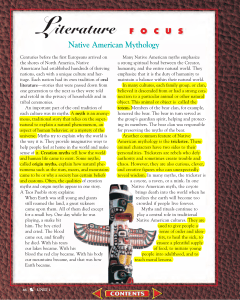II Native American Timeline 1492 --
advertisement

II Native American Timeline 1492 --- When Columbus first came in contact with native people, he wrote: "They all go around as naked as their mothers bore them; and also the women." He also noted that "they could easily be commanded and made to work, to sow and to do whatever might be needed, to build towns and be taught to wear clothes and adopt our ways," and, "they are the best people in the world and above all the gentlest." May, 1513 --- Ponce de Leon encountered Calusa Indians while exploring the Gulf Coast of Florida near Charlotte Harbor. In a fight with the Calusa, de Leon captured four warriors. July 8, 1524 --- The first kidnapping in America took place when Italian explorers kidnapped an Indian child to bring to France. April 16, 1528 --- The the first significant exploration of Florida occurred when Spanish soldier, explorer, and Indian fighter, Panfilo de Narvaez saw Indian houses near what is now Tampa Bay. Narvaez claimed Spanish royal title to the land. By fall, the Narvaez Expedition had been reduced to only four survivors, including Alvar Nuñez Cabeza de Vaca, who had been shipwrecked on Galveston Island off the Texas coast. The men were enslaved for a few years by various Native American tribes of the upper Gulf Coast 1534 --- After living six years among the Indians of the Texas coast, Cabeza de Vaca and his three fellow survivors begin their travels across Texas and the Southwest into northern Mexico. 1536 --- Cabeza de Vaca and his companions meet a band of Spanish slave hunters near Culiacan on the Mexican west coast and make their way to Mexico City, where their adventure sparks interest in the mysterious lands to the north. 1538 --- Fray Marcos de Niza, a Franciscan friar, is sent to explore the lands north of Mexico, guided by Esteban, the African-American who had accompanied Cabeza de Vaca. Within a year, Marcos returns with news of a great city called Cibola, where Esteban was killed, which from a distance appeared to him "bigger than the city of Mexico." 1539 --- Hernando de Soto lands at Tampa Bay, Florida and begins an expedition across the southeast. After defeating resisting Timucuan warriors, Hernando de Soto executed 100 of them, in the first largescale massacre by Europeans on what would become American soil. The event is known as the Napituca Massacre. 1540 --- Francisco Vasquez de Coronado led Mexico's invasion of the north with an expeditionary force of 300 conquistadors and more than one thousand Indian "allies." When they reached Cibola, they found not the promised metropolis but "a little, crowded village, looking as if it had been crumpled all up together." This was the Zuni Pueblo Indians with such a deadly sickness, that out of every 1000, over 950 of them had died, and many of them lay rotting above the ground for lack of burial." May 14, 1607 --- Jamestown is founded in Virginia by the colonists of the London Company. By the end of the year, starvation and disease reduce the original 105 settlers to just 32 survivors. Captain John Smith is captured by Native American Chief Powhatan and saved from death by the chief's daughter, Pocahontas. 1621 --- One of the first treaties between colonists and Native Americans is signed as the Plymouth Pilgrims enact a peace pact with the Wampanoag Tribe, with the aid of Squanto, an English speaking Native American. 1622-44 --- Powhatan Wars - Following an initial period of peaceful relations in Virginia, a twelve year conflict left many natives and colonists dead. Indian” tribes in what is now Louisiana. The most prominent tribes in the area at the time were the Iroquois and Illinois. 1725 --- Ten sleeping Indians were scalped by whites in New Hampshire for a bounty. 1745 --- Upon hearing of an impending French and Indian attack upon the Ulster county frontiers, Europeans massacred several Indian families in their wigwams at Walden in the Hudson River Valley. November 28, 1745 --- French military forces out of Canada, accompanied by 220 Caughnawaga Mohawk and Abenaki Indians, attacked and burned the English settlement at Saratoga. The 101 inhabitants were either killed or taken prisoner. II 1752 --- In the 1752 census, 147 "Indian" slaves -- 87 females and 60 males -- were listed as living in French households in what would later be called Illinois. These people were from different cultural groups than the local Native American population and were often captives of war. Based on the notes you took from the textbook, the timeline and the map above, describe the relationship of between the Native Americans and the colonists. Describe the relationship either with a picture or a short paragraph.











